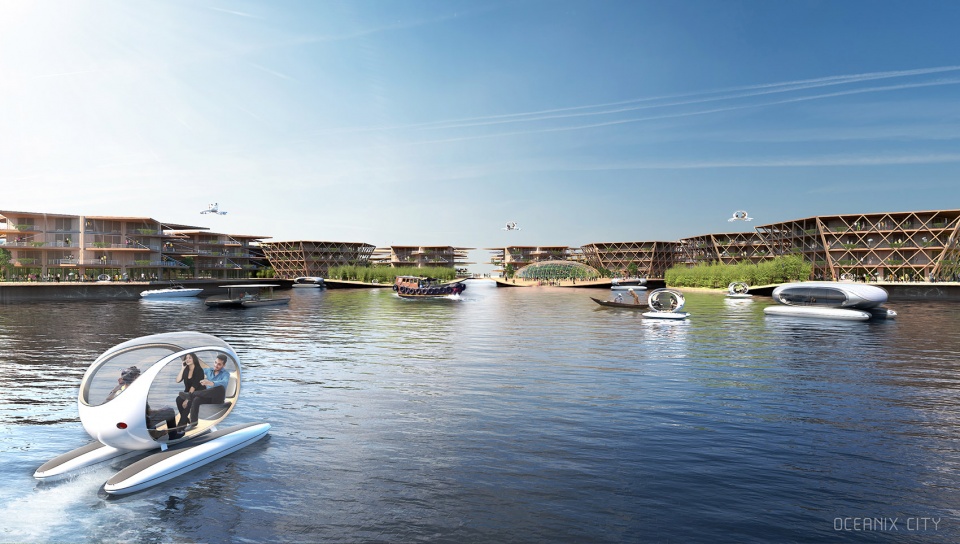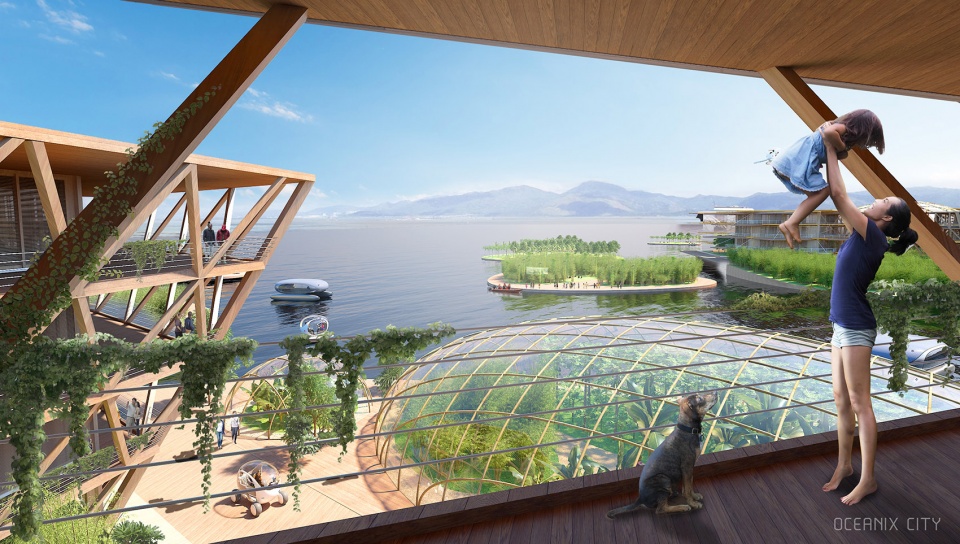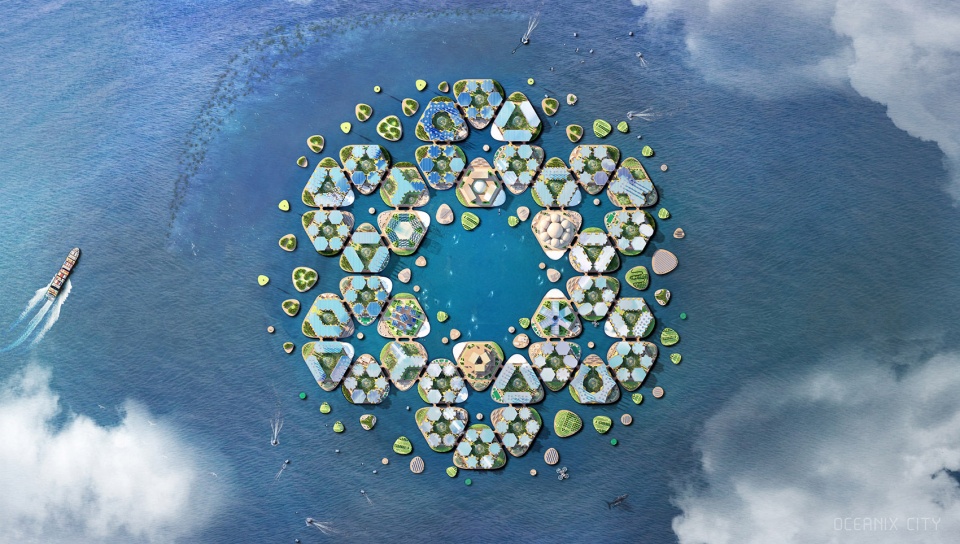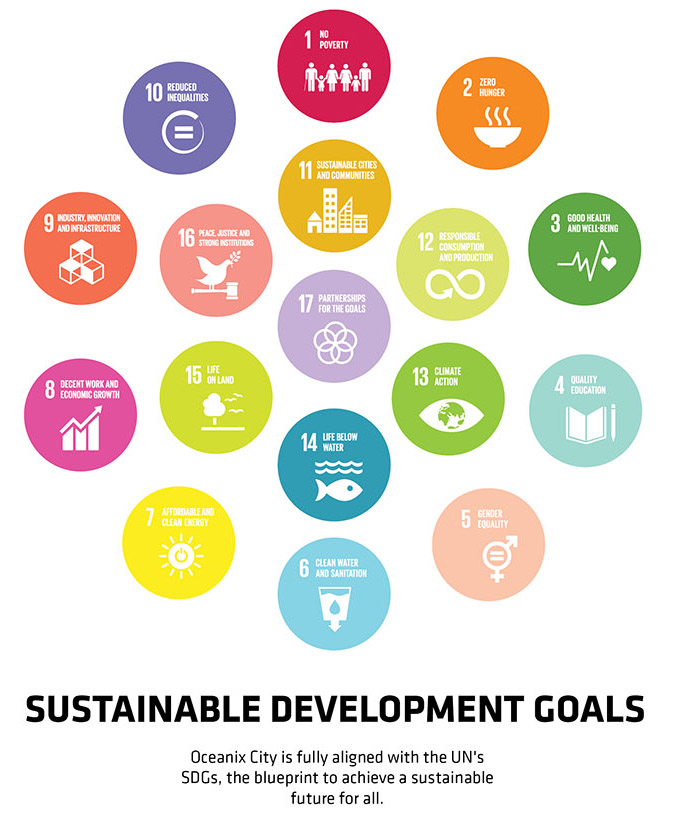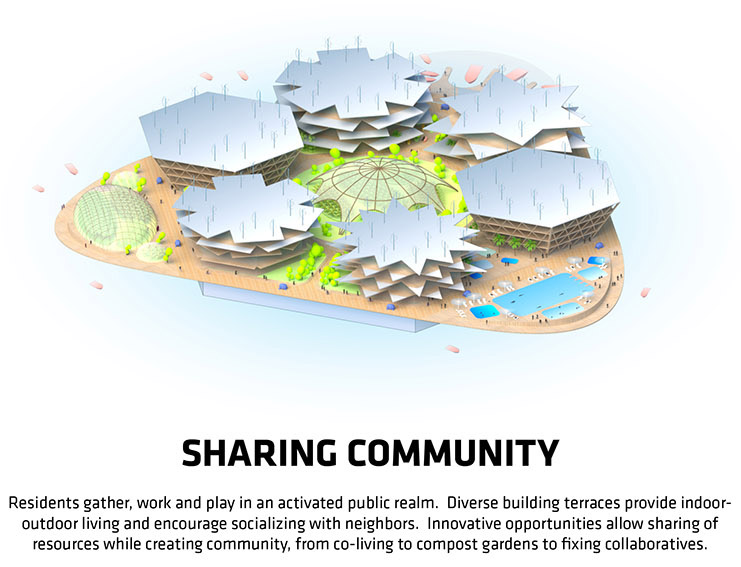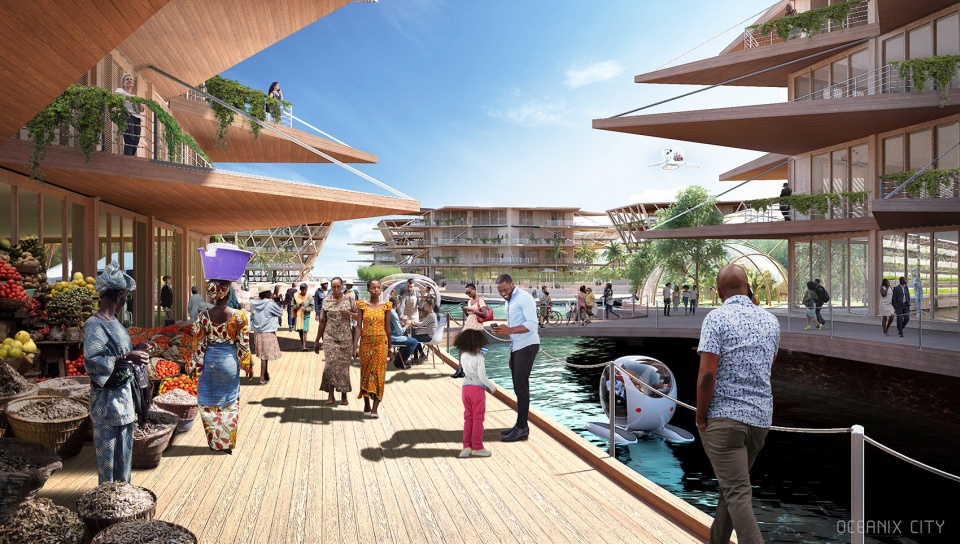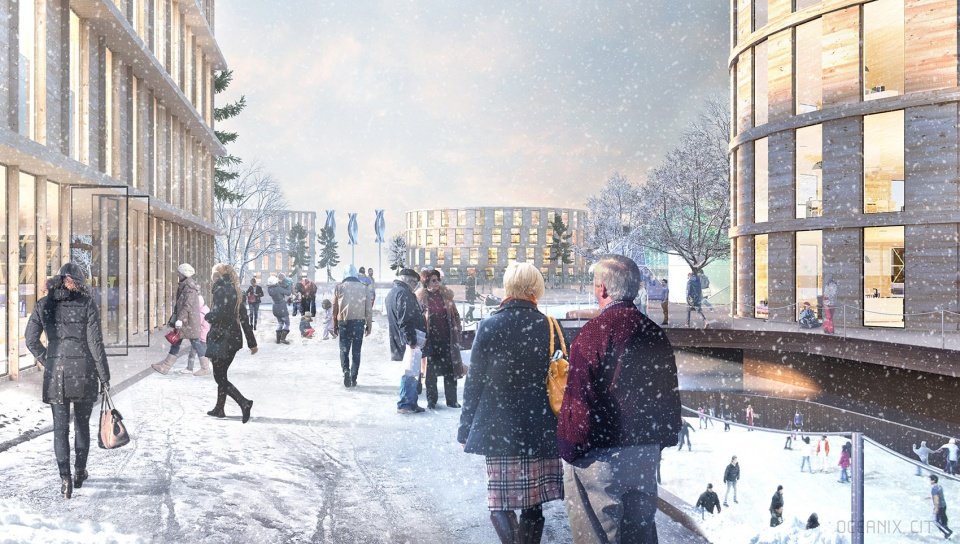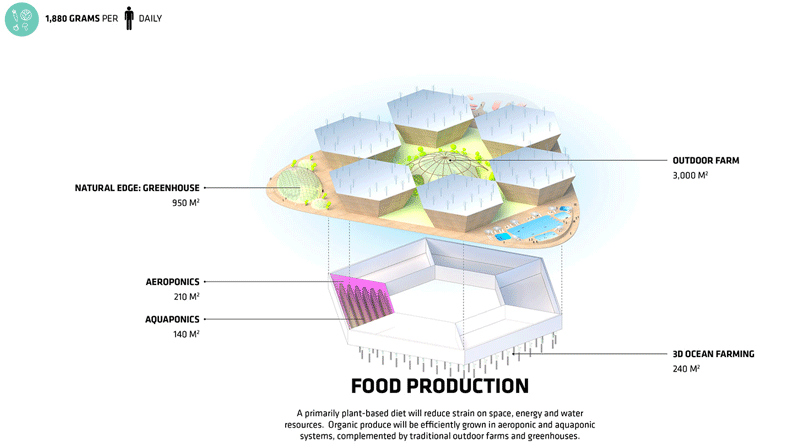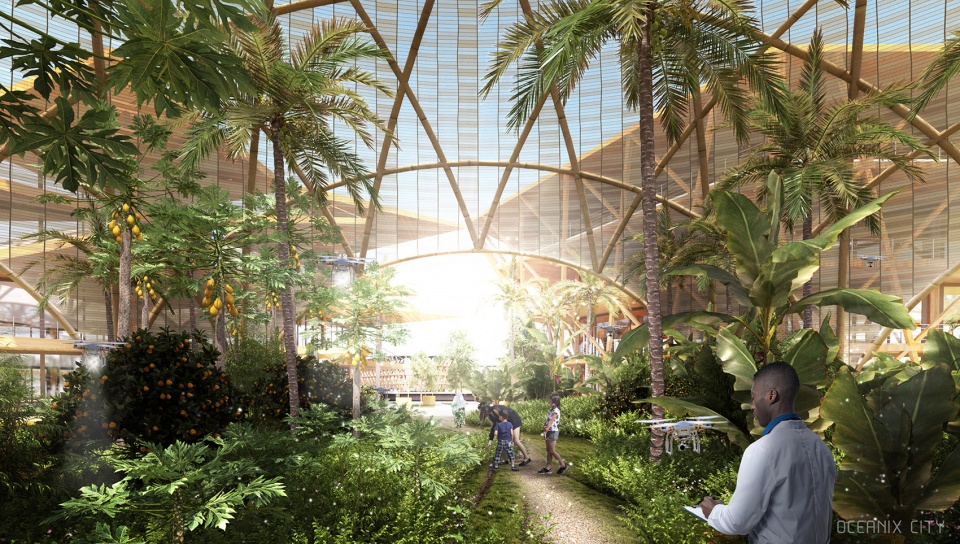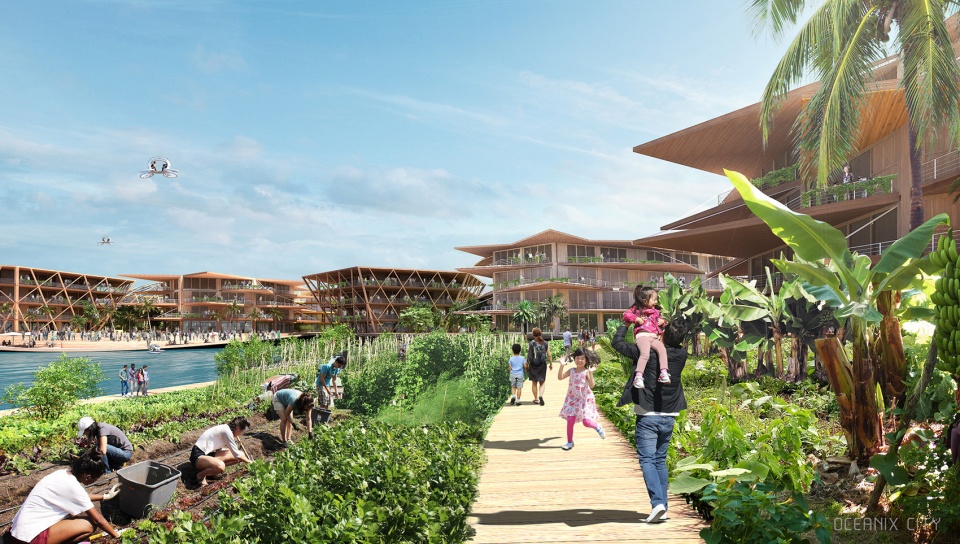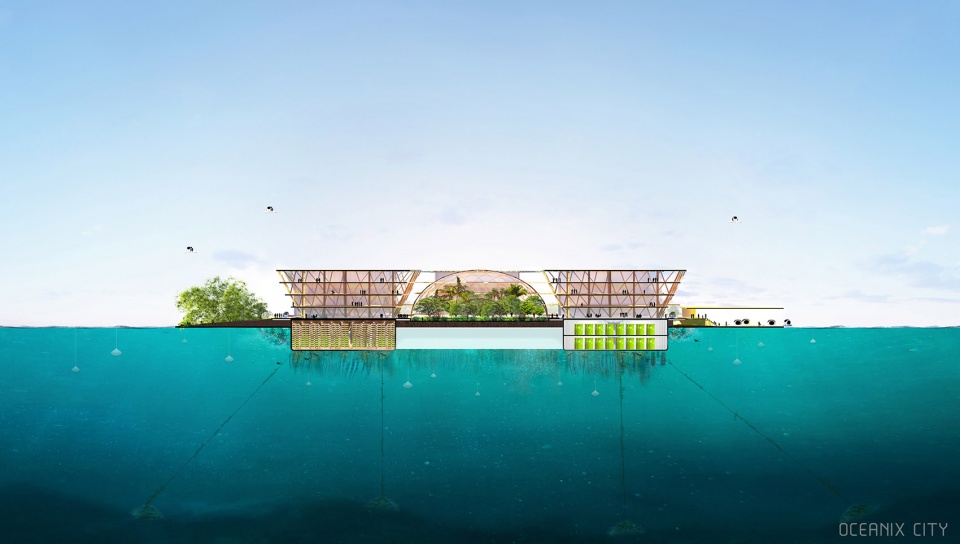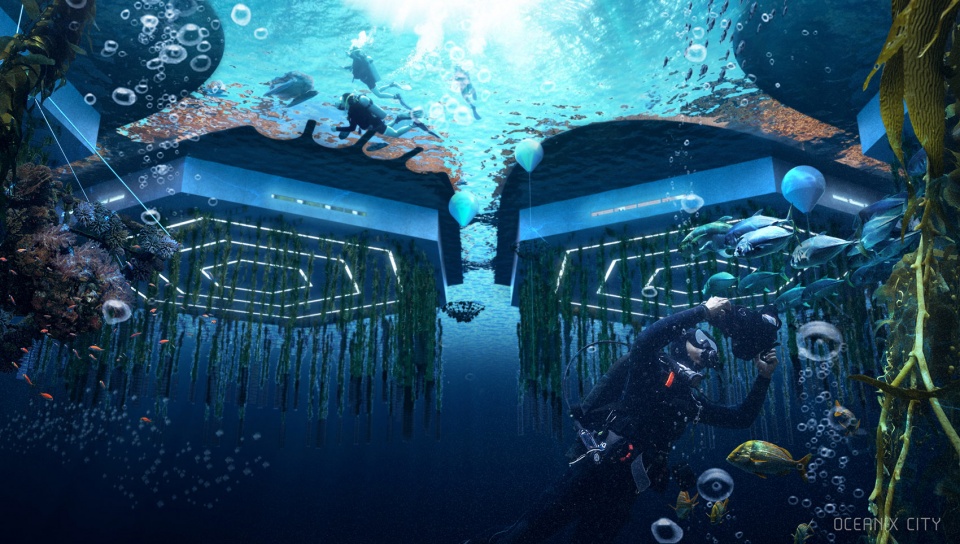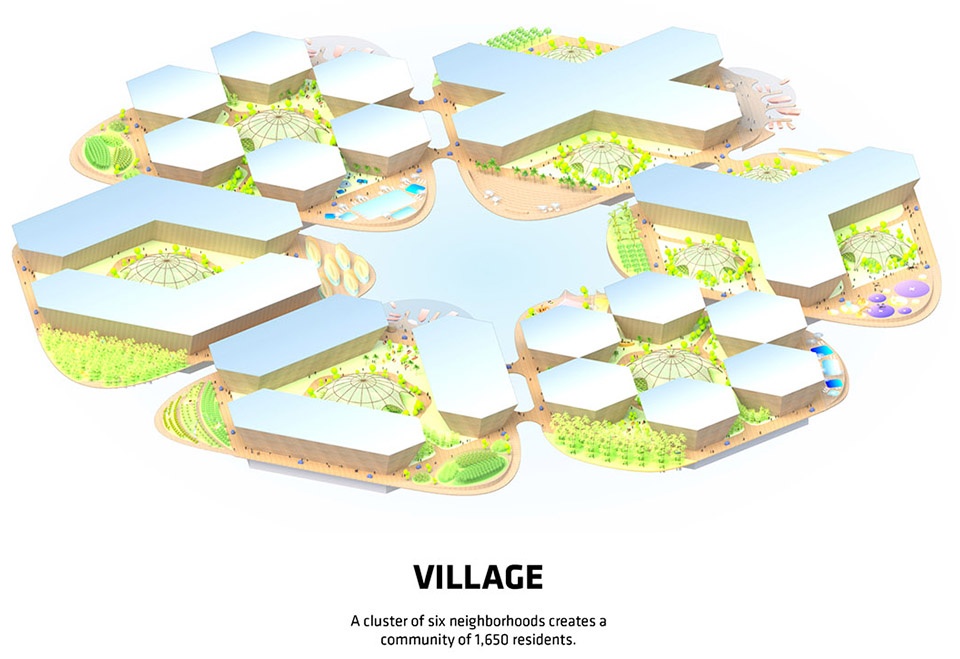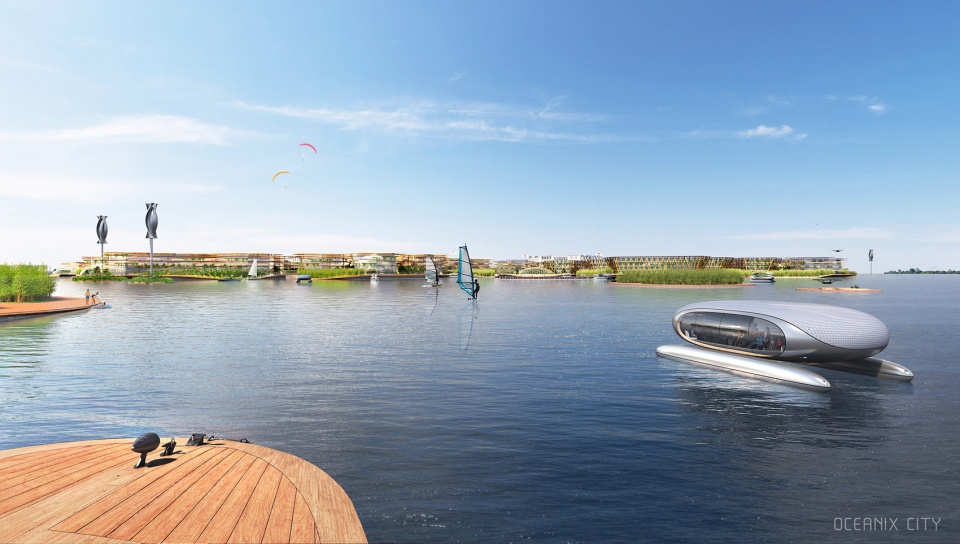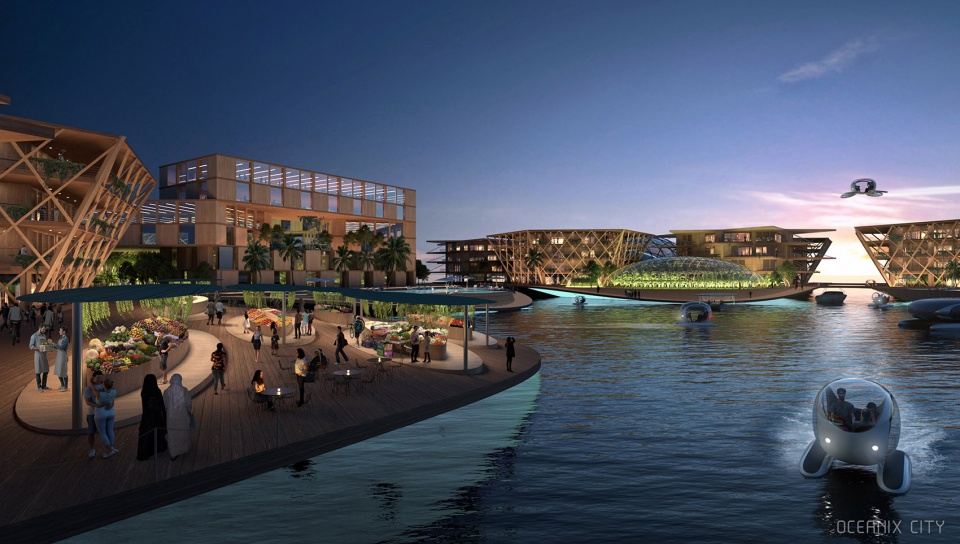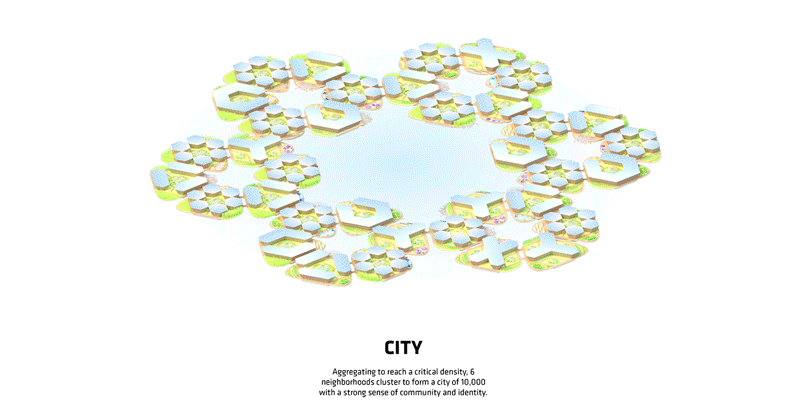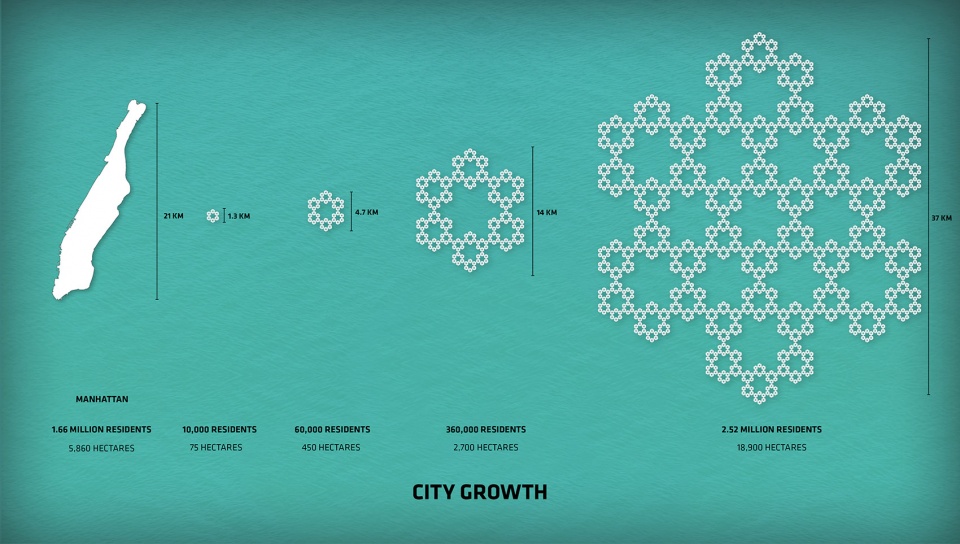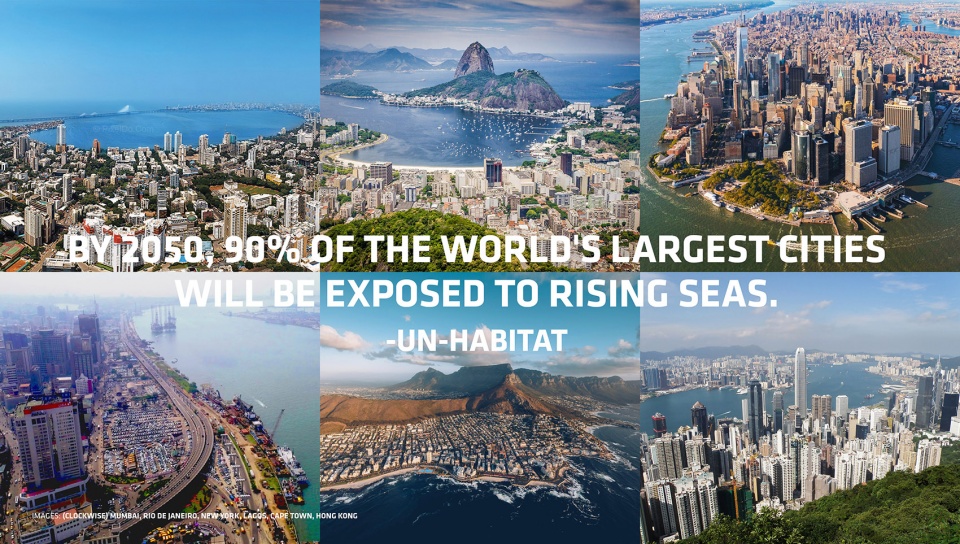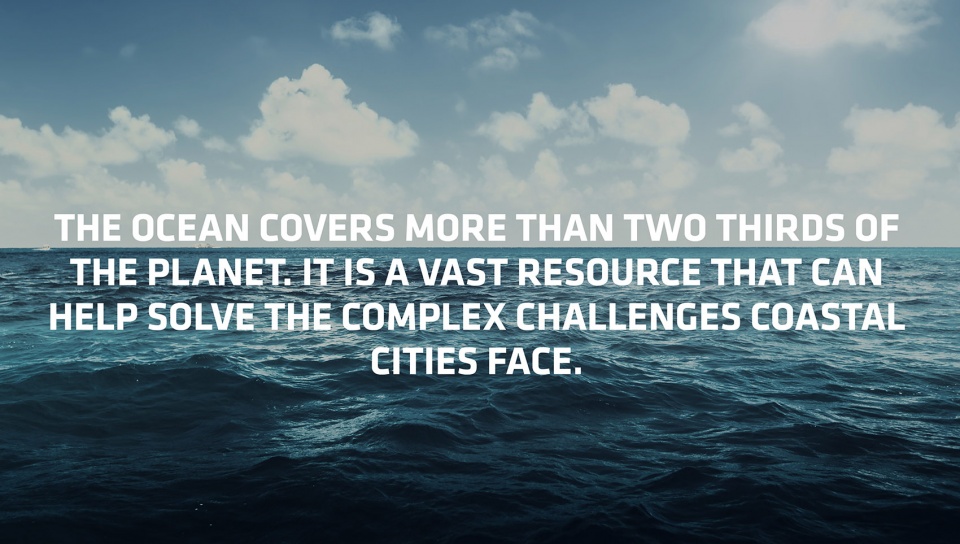全球第一个弹性化的、可持续发展的漂浮社区
非常感谢 BIG 予gooood分享以下内容。更多关于他们: BIG on gooood。
Appreciation towards BIG for providing the following description.
为响应联合国人居署的新城市议程,BIG与非盈利组织OCEANIX以及麻省理工学院海洋工程中心共同提出了Oceanix City的愿景,旨在打造全球第一个弹性化的、可持续发展的漂浮社区,能够满足1万名居住者的需求。在以“可持续漂浮城市”为主题的第一届联合国高级圆桌会议上,来自联合国总部的创新者、探险家、海洋工程师和科学家针对海平面上升对沿海城市及国家带来的威胁提出了想法和解决方案。此次圆桌会议由OCEANIX,麻省理工学院海洋工程中心和BIG共同发起。
▼Oceanix City漂浮城市概览,Oceanix City overview
As part of UN-Habitat’s New Urban Agenda, floating cities non-profit OCEANIX, the MIT Center for Ocean Engineering, BIG and partners propose a vision for the world’s first resilient and sustainable floating community for 10,000 residents: Oceanix City. The first UN high-level roundtable on Sustainable Floating Cities brought together innovators, explorers, marine engineers and scientists at the UN Headquarters to share ideas and solutions to the threats faced by coastal cities and countries due to rising sea levels. The roundtable was co-convened by OCEANIX, the MIT Center for Ocean Engineering, The Explorers Club and BIG.
▼项目生成示意,design process
联合国人居署执行理事及联合国副秘书长Maimunah Mohd Sharif表示:“与城市合作是我们作为联合国机构的职责所在,不论项目位于陆地还是水上。我们已经准备好就漂浮城市进行对话,以确保这一创新性的方案能够得到有效实施并造福民众。”
“We are the UN agency mandated to work with cities, be they on land or water. We are ready to engage in dialogue on Sustainable Floating Cities to ensure this burgeoning sector is mobilized to good effect and for the benefit of all people.” Maimunah Mohd Sharif, the Executive Director of UN-Habitat and UN Under Secretary-General.
▼项目旨在打造全球第一个弹性化的、可持续发展的漂浮社区,the project propose a vision for the world’s first resilient and sustainable floating community
预计到2050年,全球90%的最大城市将面临海平面上升的问题。绝大多数沿海城市将受到海岸侵蚀和洪水的影响,房屋和基础设施遭受冲击,导致数百万人流离失所。OCEANIX的联合创始人兼首席执行官Marc Collins Chen认为,人类可以居住在漂浮的城市中,并与水下的生物和谐相处:“这并非某种对立性的问题。现有的技术允许我们在不伤害海洋生态系统的前提下在水上居住。我们的目标是确保可持续的漂浮城市能够被所有有需要的沿海区域负担并使用,它们不该成为有钱人的特权。”
By 2050, 90% of the world’s largest cities will be exposed to rising seas. The vast majority of coastal cities will be impacted by coastal erosion and flooding, displacing millions of people, while destroying homes and infrastructure. Marc Collins Chen, Co-Founder and CEO of OCEANIX, said humans can live on floating cities in harmony with life below water. “It is not a question of one versus the other. The technology exists for us to live on water, without killing marine ecosystems. It is our goal to make sure sustainable floating cities are affordable and available to all coastal areas in need. They should not become a privilege of the rich.”
▼人类可以居住在漂浮的城市中,并与水下的生物和谐相处,humans can live on floating cities in harmony with life below water
以联合国可持续发展目标为基础,Oceanix City被构想为一个人造的生态系统,能够对能源、水、食物和废弃物的流动进行调控,从而为模块化的海洋都市创造蓝图。
Designed as a man-made ecosystem, Oceanix City is anchored in the UN Sustainable Development Goals, channeling flows of energy, water, food and waste to create a blueprint for a modular maritime metropolis.
▼可持续发展目标,Sustainable Development Goals
BIG的联合创始人Bjarke Ingels表示:“到了2050年,世界上最大城市的90%将面临海平面上升的问题。海洋可能摧毁我们,但同样可能成为我们的未来。Oceanix City是全世界第一个可持续且自给自足的漂浮社区,它是一个能够引导能源、水、食物和废弃物循环流动的人造生态系统,也是构建模块化海洋都市的蓝图。随着时间的推移,新的建筑将以有机形式不断增长、变化并适应新的需要,使300人居住的社区转变为万人居住的城市,并借助这种无限扩张的潜能,为关心彼此和地球的人们营造一个繁荣的海上家园。”
“9 out of 10 of the world’s largest cities will be exposed to rising seas by 2050. The sea is our fate – it may also be our future. The first sustainable and self-sustained floating community Oceanix City is designed as a human made ecosystem channeling circular flows of energy, water, food and waste. Oceanix City is a blueprint for a modular maritime metropolis anchored in the UN’s Sustainable Development Goals. The additive architecture can grow, transform and adapt organically over time, evolving from a neighborhood of 300 residents to a city of 10,000 – with the possibility of scaling indefinitely to provide thriving nautical communities for people who care about each other and our planet.” Bjarke Ingels, Founding Partner, BIG-Bjarke Ingels Group.
▼Oceanix City能够以有机形式不断增长、变化并适应新的需要,the additive architecture can grow, transform and adapt organically over time
社区 | Neighborhood
Oceanix City旨在通过有机式的生长、变化和适应,从一系列小型的社区发展为可以无限扩展的城市。2公顷的模块化社区最多可为300名居民提供生活、工作和聚会的空间。社区内所有建筑的高度均控制在7层以内,以保证低重心和抗风能力。每座建筑呈扇形展开,不仅能够为内部空间和公共区域带来阴凉舒适的环境,还能够有效地降低空调成本,同时使屋顶面积最大化,以捕获更多的太阳能。
Oceanix City is designed to grow, transform and adapt organically over time, evolving from neighborhoods to cities with the possibility of scaling indefinitely. Modular neighborhoods of 2 hectares create thriving self-sustaining communities of up to 300 residents with mixed-use space for living, working and gathering during day and night time. All built structures in the neighborhood are kept below 7 stories to create a low center of gravity and resist wind. Every building fans out to self-shade internal spaces and public realm, providing comfort and lower cooling costs while maximizing roof area for solar capture.
▼社区最多可为300名居民提供生活、工作和聚会的空间,modular neighborhoods create thriving self-sustaining communities of up to 300 residents with mixed-use space for living, working and gathering
每个社区平台的核心地带被用于公共农业,能够促使居民充分融入共享式的文化以及零浪费的生态系统。平台下方的海水中养殖着生物礁石、海藻、牡蛎、贻贝、扇贝和蛤蜊,能够清洁海水并加速生态系统的再生。
▼零浪费的生态系统, zero waste systems
Communal farming is the heart of every platform, allowing residents to embrace sharing culture and zero waste systems. Below sea level, beneath the platforms, biorock floating reefs, seaweed, oysters, mussel, scallop and clam farming clean the water and accelerate ecosystem regeneration.
▼每个社区的核心地带被用于公共农业,communal farming is the heart of every platform
▼平台剖面图,platform section
▼水下养殖业,underwater farming
村落 | Village
每6个社区可以围绕着一个受保护的中央港口,形成一个12公顷的大型村落,从而容纳多达1650位居民。社交、娱乐以及商业空间被设置在内环区域,以鼓励居民在村落周围聚集和流动:人们可以通过船只、电动汽车或轻松的步行穿越整座城市。
By clustering six neighborhoods around a protected central harbor, larger villages of 12 hectares can accommodate up to 1,650 residents. Social, recreational and commercial functions are placed around the sheltered inner ring to encourage citizens to gather and move around the village. Residents can easily walk or boat through the city using electric vehicles.
▼人们可以通过多种交通方式穿越整座城市,residents can easily walk or boat through the city using electric vehicles
城市 | City
进一步地,每6个村落还可聚集在一起,形成一座拥有1万人口的、有着强烈社区意识和认同感的城市。城市的中心将形成一个规模更大的港口。构成城市的六个专业化社区包含各自的公共广场、商场以及与教育、健康、体育和文化相关的地标性场所,能够在构建社区独特性的同时,为整个城市的居民提供服务。所有的社区,不论功能或规模,均优先使用当地材料进行建设,其中包括生长迅速的竹子,其抗拉强度是钢材的6倍,碳足迹为负,并且可以在社区中自由生长。
Aggregating to reach a critical density, six villages connect to form a city of 10,000 residents with a strong sense of community and identity. A larger protected harbor is formed in the heart of the city. Floating destinations and art, including six specialized landmark neighborhoods with a public square, market place and centers for spirituality, learning, health, sport and culture create destinations drawing residents from across the city and anchoring each neighborhood in a unique identity. All communities regardless of size will prioritize locally sourced materials for building construction, including fast-growing bamboo that has six times the tensile strength of steel, a negative carbon footprint, and can be grown on the neighborhoods themselves.
▼城市扩张示意,city growth
▼漂浮的城市,a floating city
漂浮城市可以在岸上进行预制,随后再运到最终场地,从而有效减少建造成本,再加上低廉的租价,最终能够创造出一种十分经济实惠的居住模型。这也就意味着,经济适用型住房很快就可以被广泛部署到那些需求迫切的沿海大城市中。第一座Oceanix Cities将首先在环境最为敏感和脆弱的热带及亚热带地区进行调试和标准化。
Floating cities can be prefabricated on shore and towed to their final site, reducing construction costs. Pairing this with the low cost of leasing space on the ocean creates an affordable model of living. These factors mean that affordable housing can be rapidly deployed to coastal megacities in dire need. The first Oceanix Cities are calibrated for the most vulnerable tropical and sub-tropical regions around the globe.
▼首批调试地点,global locations
▼解决沿海城市的海平面上升问题,sharing ideas and solutions to the threats faced by coastal cities and countries due to rising sea levels
OCEANIX CITY FACTS
CLIENT: OCEANIX
SIZE: 75 hectares
COLLABORATORS: MIT Center for Ocean Engineering, Mobility in Chain, Sherwood Design Engineers, Center for Zero Waste Design, Transsolar KlimaEngineering, Global Coral Reef Alliance, Studio Other Spaces (Olafur Eliasson and Sebastian Behmann), Dickson Despommier
BIG–BJARKE INGELS GROUP
Partners-in-Charge: Bjarke Ingels, Daniel Sundlin
Project Leaders: Alana Goldweit, Jeremy Alain Siegel
Team: Andy Coward, Ashton Stare, Autumn Visconti, Bernardo Schuhmacher, Carlos Castillo, Cristina Medina-Gonzalez, Jacob Karasik, Kristoffer Negendahl, Mai Lee, Manon Otto, Terrence Chew, Thomas McMurtrie, Tore Banke, Tracy Sodder, Walid Bhatt, Will Campion, Yushan Huang, Tore Banke, Ziyu Guo


